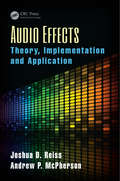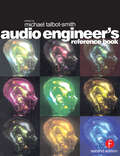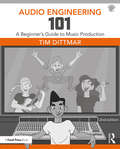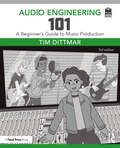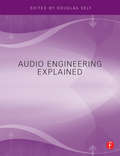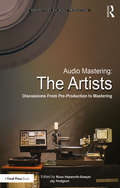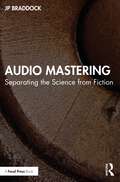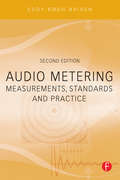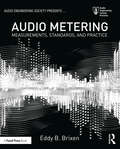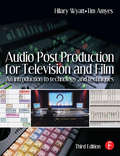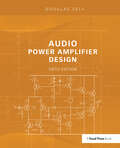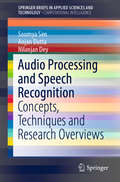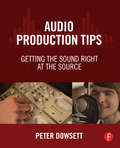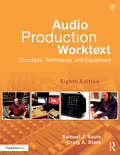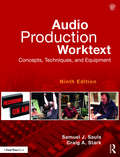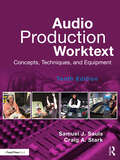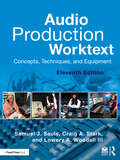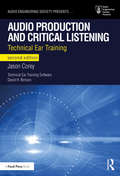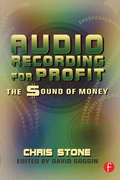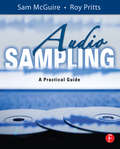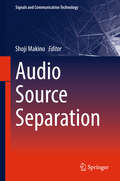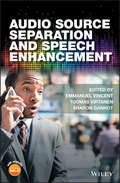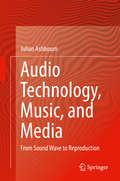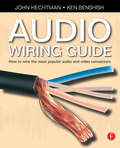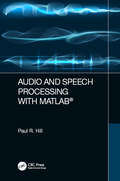- Table View
- List View
Audio Effects: Theory, Implementation and Application
by Joshua D. Reiss Andrew McPhersonAudio Effects: Theory, Implementation and Application explores digital audio effects relevant to audio signal processing and music informatics. It supplies fundamental background information on digital signal processing, focusing on audio-specific aspects that constitute the building block on which audio effects are developed. The text integrates t
Audio Engineer's Reference Book
by Michael Talbot-SmithAn authoritative reference on all aspects of audio engineering and technology including basic mathematics and formulae, acoustics and psychoacoustics, microphones, loudspeakers and studio installations. Compiled by an international team of experts, the second edition was updated to keep abreast of fast-moving areas such as digital audio and transmission technology. Much of the material has been revised, updated and expanded to cover the very latest techniques. This is a new paperback version.
Audio Engineering 101: A Beginner's Guide to Music Production
by Tim DittmarPratical, concise, and approachable, Audio Engineering 101, Second Edition covers everything aspiring audio engineers need to know to make it in the recording industry, from the characteristics of sound to microphones, analog versus digital recording, EQ/compression, mixing, mastering, and career skills. Filled with hand-on, step-by-step technique breakdowns and all-new interviews with active professionals, this updated edition includes instruction in using digital consoles, iPads for mixing, audio apps, plug-ins, home studios, and audio for podcasts. An extensive companion website features fifteen new video tutorials, audio clips, equipment lists, quizzes, and student exercises.
Audio Engineering 101: A Beginner's Guide to Music Production
by Tim DittmarPractical, concise, and approachable, the third edition of Audio Engineering 101: A Beginner’s Guide to Music Production offers readers an extensive introduction to audio engineering and music production.Featuring step-by-step breakdowns and interviews with active professionals, the book covers waveform characteristics, EQ, signal flow, acoustics, and signal processors, as well as often overlooked topics such as internships, people skills, and job opportunities in the industry. This updated edition includes answers to common questions from audio engineering students by a diverse range of professionals, as well as a more extensive chapter discussing microphones. QR codes are included throughout the book, providing readers with instant access to video and audio clips to aid in the comprehension of the material.Filled with practical advice for navigating a mysterious and confusing industry, and supported by extensive audio and video resources, Audio Engineering 101 is the go-to guide for students and audio engineers looking to succeed in the recording world.
Audio Engineering Explained
by Douglas SelfAll the design and development inspiration and direction an audio engineer needs in one blockbuster book! Douglas Self has selected the very best sound engineering design material from the Focal and Newnes portfolio and complied it into this volume. The result is a book covering the gamut of sound engineering.The material has been selected for its timelessness as well as for its relevance to contemporary sound engineering issues.
Audio Mastering: Discussions from Pre-Production to Mastering (Perspectives on Music Production)
by Jay Hodgson Russ Hepworth-SawyerAudio Mastering: The Artists collects more than twenty interviews, drawn from more than 60 hours of discussions, with many of the world’s leading mastering engineers. In these exclusive and often intimate interviews, engineers consider the audio mastering process as they, themselves, experience and shape it as the leading artists in their field. Each interview covers how engineers got started in the recording industry, what prompted them to pursue mastering, how they learned about the process, which tools and techniques they routinely use when they work, and a host of other particulars of their crafts. We also spoke with mix engineers, and craftsmen responsible for some of the more iconic mastering tools now on the market, to gain a broader perspective on their work. This book is the first to provide such a comprehensive overview of the audio mastering process told from the point-of-view of the artists who engage in it. In so doing, it pulls the curtain back on a crucial, but seldom heard from, agency in record production at large.
Audio Mastering: Separating the Science from Fiction
by JP BraddockAudio Mastering: Separating the Science from Fiction is an ideal guide to tangible development as a mastering engineer. This book offers a comprehensive overview of mastering processes, teaching the reader to link critical listening skills with analysis to comprehend the processing required to improve the quality of their audio. Whether involved in game audio, composing for film and television, producing rock or programming EDM, the aesthetics required to manipulate and assess audio for mastering are a highly valuable addition to any artist or engineer's skill set. Audio Mastering encourages readers to engage in personal analysis and, in doing so, contextualise their evaluations by linking to appropriate and available processing tools. Discussion of processing conventions and theory are included to help readers create an effective audio chain utilising the best properties from each process, as well as practical examples and additional online resources to support development of skilled processing control. This is a thorough and practical textbook for audio engineers, artists, producers and students on music production, music technology and music performance courses, and for aspiring and developing mastering engineers.
Audio Metering
by Eddy BrixenIn this comprehensive guide Eddy Bøgh Brixen will take you through the complex and confusing concept of audio metering, giving you the knowledge and skills you need to utilize optional signal levels and produce high quality audio. Covering all areas of this essential topic, Audio Metering begins with the basics- audio definitions and digital techniques, and works up to hearing and psychoacoustics. Levels in audio are defined, and the metering standards and practices are discussed, covering the existing standards abs VU and PPM, as well as the new loudness metering standards, making this the reference guide to audio metering. This new edition includes * Current information on loudness metering, covering existing and new standards, defining terms like LU, RLB, and LKFS* Explanations of music sounds and structures * An extended chapter on topics relevant to the sound engineer in the field of psychoacoustics* More details on speech intelligibility and it's measures* The skills needed for both small room acoustics and large auditoriums sound design without losing sound quality * An extended glossary Packed full of valuable information that can be applied to a wide variety of everyday tasks, this handbook is essential reading for all technicians and engineers working with acoustics, electro acoustics and audio forensics. It also provides essential information for anyone working with loudspeakers and large scale amplifiers, including sound design for theatrical and live audio set-ups.
Audio Metering: Measurements, Standards and Practice (Audio Engineering Society Presents)
by Eddy BrixenIn this comprehensive guide, Brixen takes the reader through the complex and confusing aspects of audio metering, imparting the knowledge and skills needed to utilize optional signal levels and produce high-quality audio. Covering all aspects of this fundamental subject, Audio Metering: Measurements, Standards and Practice begins with the basics, such as audio definitions and digital techniques, and works up to more complex topics like hearing and psychoacoustics. This revised and expanded third edition includes: Updated information on loudness metering, covering both existing and new standards. Definitions of terms such as LKFS, LUFS, gating, LRA. Explanations of signal types and musical sounds and structures. Further details on immersive audio. Skills needed for both small-room acoustics and large auditorium sound design without loss of sound quality. Descriptions of measurement signals and systems for audio and acoustic sound. A chapter on listening tests from small set-ups to large-scale comparisons of PA/SR-systems. Packed full of valuable information with a wide range of practical applications, this is the essential reference guide to audio metering for technicians, engineers, and tonmeisters, as well as sound designers working with acoustics, electroacoustics, broadcast, studio recording, sound art, archiving, audio forensics, and theatrical and live-audio setups.
Audio Post Production for Television and Film: An introduction to technology and techniques
by Hilary Wyatt Tim AmyesPreviously titled Audio Post-production in Video and Film, this third edition has been completely revised and restructured to provide a step-by-step guide to the professional techniques used to shape a soundtrack through the production process. Covering sound for both film and television, this edition includes many of the practical techniques and shortcuts used by experienced editors and mixers. Part one explains the basics of audio post production - how audio is recorded, how sound and picture stay in sync, how audio can be exported from system to system, and how film and video technology works. Part two follows the path of production sound from its original recording right through to the final mix, and includes sections on editing sound with picture, dialogue, sound effects and music editing, how to run ADR and Foley record sessions, and mixing, using many practical examples.Audio Post Production for Television and Film is aimed at professionals already working in the industry, newcomers, students and those considering sound for film and television as a career - in fact anyone who wants an insight into current professional practices and a comprehensive overview of the sound post production process.
Audio Power Amplifier Design
by Douglas SelfThis book is essential for audio power amplifier designers and engineers for one simple reason...it enables you as a professional to develop reliable, high-performance circuits. The Author Douglas Self covers the major issues of distortion and linearity, power supplies, overload, DC-protection and reactive loading. He also tackles unusual forms of compensation and distortion produced by capacitors and fuses. This completely updated fifth edition includes four NEW chapters including one on The XD Principle, invented by the author, and used by Cambridge Audio. Crosstalk, power amplifier input systems, and microcontrollers in amplifiers are also now discussed in this fifth edition, making this book a must-have for audio power amplifier professionals and audiophiles.
Audio Processing and Speech Recognition: Concepts, Techniques and Research Overviews (SpringerBriefs in Applied Sciences and Technology)
by Soumya Sen Nilanjan Dey Anjan DuttaThis book offers an overview of audio processing, including the latest advances in the methodologies used in audio processing and speech recognition. First, it discusses the importance of audio indexing and classical information retrieval problem and presents two major indexing techniques, namely Large Vocabulary Continuous Speech Recognition (LVCSR) and Phonetic Search. It then offers brief insights into the human speech production system and its modeling, which are required to produce artificial speech. It also discusses various components of an automatic speech recognition (ASR) system. Describing the chronological developments in ASR systems, and briefly examining the statistical models used in ASR as well as the related mathematical deductions, the book summarizes a number of state-of-the-art classification techniques and their application in audio/speech classification. By providing insights into various aspects of audio/speech processing and speech recognition, this book appeals a wide audience, from researchers and postgraduate students to those new to the field.
Audio Production Tips: Getting the Sound Right at the Source
by Peter DowsettAudio Production Tips: Getting the Sound Right at the Source provides practical and accessible information detailing the production processes for recording today’s bands. By demonstrating how to "get the sound right at the source," author Peter Dowsett lays the appropriate framework to discuss the technical requirements of optimizing the sound of a source. Through its coverage of critical listening, pre-production, arrangement, drum tuning, gain staging and many other areas of music production, Audio Production Tips allows you to build the wide array of skills that apply to the creative process of music production. Broken into two parts, the book first presents foundational concepts followed by more specific production advice on a range of instruments. Key features: Important in-depth coverage of music theory, arrangement and its applications. Real life examples with key references to the author’s music production background. Presents concepts alongside the production of a track captured specifically for the book. A detailed companion website, including audio, video, Pro Tools session files of the track recording process, and videos including accompanying audio that can be examined in the reader’s DAW. Please visit the accompanying companion website, available at www.audioproductiontips.com, for resources that further support the book’s practical approach.
Audio Production Worktext: Concepts, Techniques, and Equipment
by Samuel J. Sauls Craig A. StarkThis is an excellent introduction to the modern radio production studio, the equipment found in that studio, and the basic techniques needed to accomplish radio production work. The new edition is updated throughout and features new sections on mobile technology, audio editing apps and software, and digital editing, as well as updated graphics and expanded content on portable digital audio players. Features a worktext/website format tailored for both students and teachers, offering a solid foundation for anyone who wishes to know more about radio/audio equipment and production techniques.
Audio Production Worktext: Concepts, Techniques, and Equipment
by Samuel J. Sauls Craig A. StarkAudio Production Worktext, 9th Edition provides readers the best introduction to audio and radio production. It shows how to navigate modern radio production studios and utilize the latest equipment and software. The 9th edition is updated to cover new mobile technologies, digital consoles, and audio editing apps and software, as well sound for the visual media and Internet radio. The new edition continues to include the worktext/website format tailored for both students and teachers and features like Production Tips that provide notes relevant to various audio production topics, self-study questions and projects, an updated Glossary, and an up-to-date companion website with invaluable student and instructor materials. Included in this edition are offers and features from Pro Sound Effects, FilmTVsound.com, and RadioFX, as well as updated color graphics and images throughout the text.
Audio Production Worktext: Concepts, Techniques, and Equipment
by Samuel J. Sauls Craig A. StarkNow in its tenth edition, the Audio Production Worktext offers a comprehensive introduction to audio production in radio, television, and film. This hands-on, student-friendly text demonstrates how to navigate modern radio production studios and utilize the latest equipment and software. Key chapters address production planning, the use of microphones, audio consoles, and sound production for the visual media. The reader is shown the reality of audio production both within the studio and on location. New to this edition is material covering podcasting, including online storage and distribution. The new edition also includes an updated glossary and appendix on analog and original digital applications, as well as self-study questions and projects that students can use to further enhance their learning. The accompanying instructor website has been refreshed and includes an instructor’s manual and PowerPoint images. This book remains an essential text for audio and media production students seeking a thorough introduction to the field.
Audio Production Worktext: Concepts, Techniques, and Equipment
by Samuel J. Sauls Craig A. Stark Lowery A. Woodall IIINow in its eleventh edition, Audio Production Worktext offers a comprehensive introduction to audio production in radio, podcasting, television, and film.This hands-on, student-friendly text demonstrates how to navigate modern radio production studios and utilize the latest equipment and software. Key chapters address production planning, the use of microphones, audio consoles, and sound production for visual media. The reader is shown the reality of audio production both within the studio and on location. In this new edition, chapters have been reorganized to address the growing prominence of podcasting and digital production. Thorough updates have been made to every chapter, including self-study questions and projects, and the authors continue to draw in diverse and international practitioner perspectives to help translate concepts to real-world practice.This book remains an essential text for audio and media production students seeking a thorough introduction to the field.The accompanying website for students and instructors has also been updated and includes sample syllabi, lesson plans, further study questions, test questions, and web resources, as well as images by chapter as included in the Worktext.
Audio Production and Critical Listening: Technical Ear Training (Audio Engineering Society Presents)
by Jason CoreyAudio Production and Critical Listening: Technical Ear Training, Second Edition develops your critical and expert listening skills, enabling you to listen to audio like an award-winning engineer. Featuring an accessible writing style, this new edition includes information on objective measurements of sound, technical descriptions of signal processing, and their relationships to subjective impressions of sound. It also includes information on hearing conservation, ear plugs, and listening levels, as well as bias in the listening process. The interactive web browser-based "ear training" software practice modules provide experience identifying various types of signal processes and manipulations. Working alongside the clear and detailed explanations in the book, this software completes the learning package that will help you train you ears to listen and really "hear" your recordings. This all-new edition has been updated to include: Audio and psychoacoustic theories to inform and expand your critical listening practice. Access to integrated software that promotes listening skills development through audio examples found in actual recording and production work, listening exercises, and tests. Cutting-edge interactive practice modules created to increase your experience. More examples of sound recordings analysis. New outline for progressing through the EQ ear training software module with listening exercises and tips.
Audio Recording for Profit: The Sound of Money
by Chris StoneThis book is the first real inside look at the business of professional audio recording, which fuels a multibillion dollar global music industry. Industry pioneer Chris Stone, founder of the legendary Record Plant, provides hard-earned business strategies, guidelines, and advice on every aspect of launching and managing a professional audio recording business. This book is for every audio profit center - from the project studio in the garage to the multi-room diversified recording facility. With 30 years of practical business experience, Mr. Stone reveals the secrets of profitable survival in the pro audio world of today and tomorrow. Why be a player in the professional audio recording industry? What is the attraction and potential payoff? How big an operation are you contemplating? To succeed, one must categorize the various types and sizes of pro audio facilities and their customer bases. It is also essential to understand creative management, marketing, promotion, and the modern economics of pro audio. The professional of tomorrow anticipates recording for new media and is prepared for diversification. All of these issues and more are addressed in this book.
Audio Sampling: A Practical Guide
by Sam McGuire Roy PrittsBringing sampling to a new generation of audio engineers and composers Audio Sampling explains how to record and create sampled instruments in a software setting. There are many things that go into creating a sampled instrument and many things that can go wrong, this book is a step by step guide through the process, from introducing sampling, where it begins to recording editing and using samples, providing much sought after detailed information on the actual process of sampling, creating sampled instruments as well as the different ways they can be used. The software used is the NN-XT a sampler that is a part of the Reason studio software and ProTools LE, however the material discussed is applicable and can be used with any sampler. The companion website has exclusive material including a comprehensive comparison of the different hardware software available, as well as audio examples and video clips from each stage of the process
Audio Source Separation (Signals And Communication Technology)
by Shoji MakinoOffers the first comprehensive treatment of audio source separation based on non-negative matrix factorization, deep neural network, and sparse component analysis.<P><P> Describes fundamentals and application of state-of-the-art audio source separation techniques.<P> Presents a comprehensive, authoritative, and accessible treatment to the subject matter.<P>This book provides the first comprehensive overview of the fascinating topic of audio source separation based on non-negative matrix factorization, deep neural networks, and sparse component analysis.<P> The first section of the book covers single channel source separation based on non-negative matrix factorization (NMF). After an introduction to the technique, two further chapters describe separation of known sources using non-negative spectrogram factorization, and temporal NMF models. In section two, NMF methods are extended to multi-channel source separation. Section three introduces deep neural network (DNN) techniques, with chapters on multichannel and single channel separation, and a further chapter on DNN based mask estimation for monaural speech separation. In section four, sparse component analysis (SCA) is discussed, with chapters on source separation using audio directional statistics modelling, multi-microphone MMSE-based techniques and diffusion map methods.<P> The book brings together leading researchers to provide tutorial-like and in-depth treatments on major audio source separation topics, with the objective of becoming the definitive source for a comprehensive, authoritative, and accessible treatment. This book is written for graduate students and researchers who are interested in audio source separation techniques based on NMF, DNN and SCA.
Audio Source Separation and Speech Enhancement
by Tuomas Virtanen Emmanuel Vincent Sharon GannotLearn the technology behind hearing aids, Siri, and Echo Audio source separation and speech enhancement aim to extract one or more source signals of interest from an audio recording involving several sound sources. These technologies are among the most studied in audio signal processing today and bear a critical role in the success of hearing aids, hands-free phones, voice command and other noise-robust audio analysis systems, and music post-production software. Research on this topic has followed three convergent paths, starting with sensor array processing, computational auditory scene analysis, and machine learning based approaches such as independent component analysis, respectively. This book is the first one to provide a comprehensive overview by presenting the common foundations and the differences between these techniques in a unified setting. Key features: Consolidated perspective on audio source separation and speech enhancement. Both historical perspective and latest advances in the field, e.g. deep neural networks. Diverse disciplines: array processing, machine learning, and statistical signal processing. Covers the most important techniques for both single-channel and multichannel processing. This book provides both introductory and advanced material suitable for people with basic knowledge of signal processing and machine learning. Thanks to its comprehensiveness, it will help students select a promising research track, researchers leverage the acquired cross-domain knowledge to design improved techniques, and engineers and developers choose the right technology for their target application scenario. It will also be useful for practitioners from other fields (e.g., acoustics, multimedia, phonetics, and musicology) willing to exploit audio source separation or speech enhancement as pre-processing tools for their own needs.
Audio Technology, Music, and Media: From Sound Wave to Reproduction
by Julian AshbournThis book provides a true A to Z of recorded sound, from its inception to the present day, outlining how technologies, techniques, and social attitudes have changed things, noting what is good and what is less good. The author starts by discussing the physics of sound generation and propagation. He then moves on to outline the history of recorded sound and early techniques and technologies, such as the rise of multi-channel tape recorders and their impact on recorded sound. He goes on to debate live sound versus recorded sound and why there is a difference, particularly with classical music. Other topics covered are the sound of real instruments and how that sound is produced and how to record it; microphone techniques and true stereo sound; digital workstations, sampling, and digital media; and music reproduction in the home and how it has changed. The author wraps up the book by discussing where we should be headed for both popular and classical music recording and reproduction, the role of the Audio Engineer in the 21st century, and a brief look at technology today and where it is headed. This book is ideal for anyone interested in recorded sound. “[Julian Ashbourn] strives for perfection and reaches it through his recordings… His deep knowledge of both technology and music is extensive and it is with great pleasure that I see he is passing this on for the benefit of others. I have no doubt that this book will be highly valued by many in the music industry, as it will be by me.” -- Claudio Di Meo, Composer, Pianist and Principal Conductor of The Kensington Philharmonic Orchestra, The Hemel Symphony Orchestra and The Lumina Choir
Audio Wiring Guide: How to wire the most popular audio and video connectors
by John HechtmanWhether you're a pro or an amateur, a musician or into multimedia, you can't afford to guess about audio wiring. The Audio Wiring Guide is a comprehensive, easy-to-use guide that explains exactly what you need to know. No matter the size of your wiring project or installation, this handy tool provides you with the essential information you need and the techniques to use it. Using The Audio Wiring Guide is like having an expert at your side. By following the clear, step-by-step directions, you can do professional-level work at a fraction of the cost. Every step is clearly explained and photo-illustrated. All the common audio connectors are covered as well as most special-use multimedia connectors. It is the perfect guide to keep by your side in the studio or on the road.
Audio and Speech Processing with MATLAB
by Paul HillSpeech and audio processing has undergone a revolution in preceding decades that has accelerated in the last few years generating game-changing technologies such as truly successful speech recognition systems; a goal that had remained out of reach until very recently. This book gives the reader a comprehensive overview of such contemporary speech and audio processing techniques with an emphasis on practical implementations and illustrations using MATLAB code. Core concepts are firstly covered giving an introduction to the physics of audio and vibration together with their representations using complex numbers, Z transforms and frequency analysis transforms such as the FFT. Later chapters give a description of the human auditory system and the fundamentals of psychoacoustics. Insights, results, and analyses given in these chapters are subsequently used as the basis of understanding of the middle section of the book covering: wideband audio compression (MP3 audio etc.), speech recognition and speech coding. The final chapter covers musical synthesis and applications describing methods such as (and giving MATLAB examples of) AM, FM and ring modulation techniques. This chapter gives a final example of the use of time-frequency modification to implement a so-called phase vocoder for time stretching (in MATLAB). Features A comprehensive overview of contemporary speech and audio processing techniques from perceptual and physical acoustic models to a thorough background in relevant digital signal processing techniques together with an exploration of speech and audio applications. A carefully paced progression of complexity of the described methods; building, in many cases, from first principles. Speech and wideband audio coding together with a description of associated standardised codecs (e.g. MP3, AAC and GSM). Speech recognition: Feature extraction (e.g. MFCC features), Hidden Markov Models (HMMs) and deep learning techniques such as Long Short-Time Memory (LSTM) methods. Book and computer-based problems at the end of each chapter. Contains numerous real-world examples backed up by many MATLAB functions and code.
